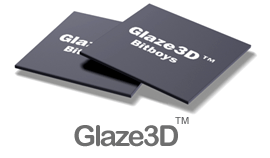 The
transistor count for the Glaze3D core is listed as 1.5 million, considerably
less than the competition, yet you claim to support almost every imaginable
feature. How have you been able to accomplish such efficiency?
The
transistor count for the Glaze3D core is listed as 1.5 million, considerably
less than the competition, yet you claim to support almost every imaginable
feature. How have you been able to accomplish such efficiency?
At this time we are not going into detail on the XBA architecture.
What's the transistor count with the embedded DRAM included?
Not releasing at this point.
The core of the Glaze3D is listed as 150MHz, despite the 0.20micron process that it will be manufactured on. The transistor count also seems quite low, suggesting relatively low heat output. What is holding back the clock speed?
The speeds of our architecture will increase over time and products generations. The 150 MHz is in line with the other chips coming out this year, considering that we don't really need much more clock frequency as we have an eight-texel pipeline instead of a two-texel pipeline like the upcoming Voodoo5 or the four-texel engine of the Geforce products. Running an eight-texel pipeline at 150 MHz is like running a two-texel pipeline like Voodoo5 at 600 MHz!
What sort of performance increase can we expect solely from the addition of embedded DRAM?
It will enable the part to hit the actual peak fill rates quoted. Other architecture we know will be memory bandwidth limited in higher resolutions, color depths and scene complexities, the fact is they will not be able to achieve their quoted fillrate numbers because of their memory bandwidth ceilings.
What performance hit occurs when external DRAM is accessed?
For the Glaze3D 1200 we can support 1024x768 at true color in the edram. Higher true color resolutions will have the color buffer in the external SDRAM memory. The required color buffer bandwidth is about half of the Z buffer bandwidth, so putting it to the SDRAM doesn't really hurt us much.
In fact, in some resolutions and dependent on the texture scheme we could see better speeds with this combined solution, as then we can combine the bandwidths of both memory types.
The Glaze3D 2400 will support 1280x1024 in true color inside the internal frame buffer, and use a similar structure as mentioned above in the 1600x1200 resolutions.
Will all Glaze3D chips include the 9MB of embedded DRAM, or will there be a model that runs purely off external DRAM?
All Bitboys products will be XBA enabled. The type of 3D performance we are talking about cannot be achieved without it.
The 9MB figure is a bit odd - usually we see memory in 2, 4, 8, 16, 32MB, etc. chunks. How was this figure arrived at?
It accommodates 1024x768x32bit color completely inside the edram in a single chip configurations, and 1280x1024x32 bit color in a dual chip configuration.
Which memory types are supported for external DRAM?
SDRAM and SGRAM
How do you decide which information is critical to be stored in the embedded DRAM?
It is dependent on many factors including resolution, color depth, Z depth, texture size, etc. We make the best determination of where to locate the information based upon needed bandwidths.
What kind of frame rates can we expect from a Glaze3D 1200 in Quake 3 at 1024x768x32 and 1600x1200x32? How about the 2400?
It is hard to speculate, but I do not think we will disappoint with the 1200 and the 2400 is going to be amazing!
Will the Glaze3D be a reasonable professional 3D graphics solution? The XBA architecture does lend itself very well to the workstation market, however at this time we will be focusing on the entertainment segment of the 3D graphics industry.
How do the 2 Glaze3D chips interact in the 2400 model? Is it similar to 3dfx's SLI, ATI's AFR, Metabyte's PGP, or is it something completely different?
It is a proprietary scheme that is unlike any other currently offered solution.
The specifications mention that 4 Glaze3D chips can work together, but no such product is listed on your website. Are there any plans for one?
At this time our full efforts are on the 1200 an 2400.










0 Comments
View All Comments